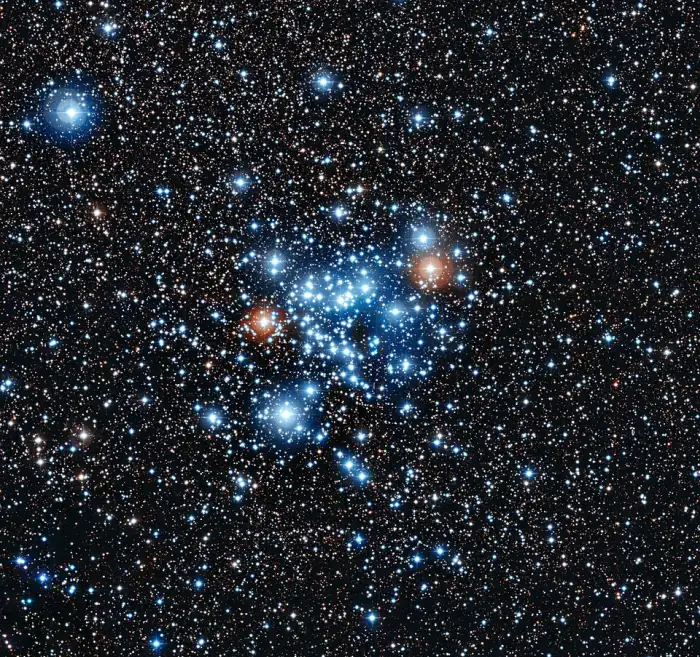The Pearl Cluster is a bright open cluster located 5,500 light-years away in the southern constellation of Centaurus (the Centaur). With an apparent magnitude of 5.3 and an angular size of 12 arcminutes, it can be seen in binoculars and small telescopes. The cluster is listed as NGC 3766 in the New General Catalogue and Caldwell 97 (C97) in the Caldwell catalogue.
The Pearl Cluster is part of the Carina molecular cloud complex, a vast stellar nursery that also includes the bright Carina Nebula (NGC 3372), a large star-forming region in the neighbouring constellation Carina. The star cluster has an estimated age of only 14.4 million years. It is moving towards us at 14.8 km/s.
In 2013, astronomers at the Geneva Observatory discovered a new type of variable star in the Pearl Cluster. They found that NGC 3766 contains 36 fast-rotating pulsating B-type stars. These periodic variable stars are still on the main sequence and are not expected to be pulsating. They are slightly hotter and brighter than the Sun. Some of them spin at rotational velocities that are more than half of their critical velocity.

This spectacular group of young stars is the open star cluster NGC 3766 in the constellation of Centaurus (The Centaur). Very careful observations of these stars by a group from the Geneva Observatory using the Swiss 1.2-metre Leonhard Euler Telescope at ESO’s La Silla Observatory in Chile have shown that 36 of the stars are of a new and unknown class of variable star. This image was taken with the MPG/ESO 2.2-metre telescope at the La Silla Observatory. Image credit: ESO (CC BY 4.0)
Observations with the Swiss 1.2-metre Leonhard Euler telescope at ESO’s La Silla Observatory in Chile over a period of seven years revealed that the stars are more luminous than Delta Scuti variables and fainter than slowly pulsating B-type stars (53 Persei variables). The brightness of these young stars varies by only a few hundredths of a magnitude with periods between 2 and 20 hours. The cause of the brightness variations is unclear.
Astronomers have also detected two red supergiants and four Ap stars (chemically peculiar A-type stars) in the cluster.
Facts
The open cluster NGC 3766 was discovered by the French astronomer Nicolas Louis de Lacaille on March 5, 1752. Lacaille spent several years studying the far southern sky from the Cape of Good Hope in South Africa and is credited for creating 14 southern constellations that are still in use today. He catalogued the star cluster as Lacaille III.7.
The Pearl Cluster appears near the Lambda Centauri Nebula (IC 2944) in the sky. Popularly known as the Running Chicken Nebula, IC 2944 is an open cluster with an emission nebula located approximately 6,500 light-years away. With an apparent magnitude of 4.5 and an angular size of 75 arcminutes, the young star cluster may be glimpsed without binoculars on a clear, dark night.

Wide field photo of the Crux (Southern Cross) constellation. The Coalsack Nebula can be seen as the dark area below-right in the constellation. The Pearl Cluster is visible to the right of Acrux, the southernmost star of the Southern Cross. The cluster appears just above Lambda Centauri and the pink and reddish nebulosity of the Running Chicken Nebula. Image credit: Wikimedia Commons/Naskies (CC BY-SA 3.0)
Location
The Pearl Cluster lies north of the Running Chicken Nebula (IC 2944), close to the imaginary line connecting Imai in the Southern Cross and Theta Carinae in the Diamond Cross. The cluster appears just northeast of Lambda Centauri, the brightest point of light roughly halfway between Imai (Delta Crucis) and Theta Carinae.
The Southern Cross is one of three diamond-shaped asterisms in the far southern sky. It is brighter than the False Cross, formed by Avior, Aspidiske, Alsephina and Markeb, and the Diamond Cross, formed by Miaplacidus with Theta, Upsilon and Omega Carinae. The three conspicuous asterisms can be used to find many bright deep sky objects in the region, including the Carina Nebula (NGC 3372), the Southern Pleiades (Theta Carinae Cluster, IC 2602), the Wishing Well Cluster (NGC 3532), the Running Chicken Nebula (IC 2944), and the Jewel Box Cluster (NGC 4755).

The location of the Pearl Cluster (NGC 3766), image: Stellarium
At declination -61° 37’, NGC 3766 is best seen from the southern hemisphere. The cluster never rises above the horizon for observers north of the latitude 28° N. It only appears low in the sky from the northern tropical latitudes. It is invisible from Europe and most of the United States.
The best time of the year to observe the Pearl Cluster, the Lambda Centauri Nebula, and other deep sky objects in Centaurus is during the month of May, when the constellation appears higher above the horizon around 9 pm.
Pearl Cluster – NGC 3766
| Constellation | Centaurus |
| Object type | Open cluster |
| Right ascension | 11h 36m 14.6s |
| Declination | −61° 36′ 58′′ |
| Apparent magnitude | 5.3 |
| Apparent size | 12’ |
| Distance | 5,500 light-years (1,686 parsecs) |
| Radius | 9.6 light-years |
| Age | 14.4 million years |
| Names and designations | Pearl Cluster, NGC 3766, Caldwell 97, Melotte 107 (Mel 107), Collinder 248 (Cr 248), BRAN 360, VDBH 120, OCl 860.0, MWSC 1958, C 1133-613 |